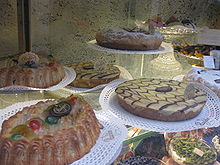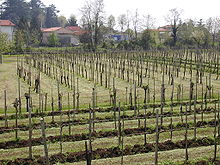- Venetian cuisine
-
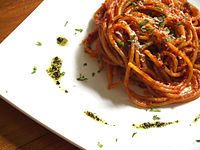
This article is part of the series Italian cuisine
Cucina italianaHistoryAncient Rome • Middle-Ages • Renaissance • Modern times
DishesMain articlePastas
Spaghetti • Macaroni • Tagliatelle • Orecchiette • Trenette • Agnolotti • Ravioli • Tortellini • Gnocchi • Fusilli • Lasagna • Carbonara • Pesto • Ragù • PuttanescaOthers
Pizza • Cotoletta • Baccala • Cotechino and Zampone • Bresaola • Mortadella • Arancini • PizzoccheriDessertsMain categoryTiramisu • Panettone • Cassata • Zuppa Inglese • Cannoli • Gelato • Granita • Pandoro • Easter cake • Panna cotta
WinesMain articleVeneto • Tuscany • Piedmont • Calabria • Lombardy • Friuli-Venezian Giulia
BeveragesBeer & breweries • Liquor & liqueurs
Beer • Espresso • Cappuccino • Caffelatte • Caffè macchiato • Caffè corretto
See alsoItalian-American • San Marino • Italian-style coffeehouse • Italian-style eating house • Chefs and cooks • Meal structure
 Italy portal
Italy portalVenetian cuisine (from the city of Venice[1] or more widely in the region of Veneto, Italy) has a centuries-long history, and it is significantly different from the other cuisines of North Italy as well as neighbouring Austria and Slavic countries, despite having something in common with all these.
Contents
Overview
Venetian cuisine may be divided into three main kinds of cuisine, the one in the coastal areas, the one in the plains, and the one in the mountain areas: the second one includes many local cuisines, having each city its own dishes.
The most common dish is polenta, which is cooked in various ways within the local cuisines of Veneto.
Coastal areas serve mainly seafood dishes, and its cuisine is common to Venice's one.
In the plains it is very popular to serve grilled meat (often by a barbecue, and in a mix of pork, beef and chicken meat) together with grilled polenta, potatoes or vegetables. A very popular dishes is also risotto, rice cooked with many different kinds of food, from vegetables, mushrooms, pumpkin or radicchio to seafood, pork meat or chicken livers. Bigoli (a typical Venetian fresh pasta, similar to a thicker kind of spaghetti), fettuccine (hand-made noodles), ravioli and the similar tortelli (filled with meat, cheese, vegetables or pumpkin) and gnocchi (potatoes-made fresh pasta), are fresh and often hand-made pasta dishes (made of eggs and wheat flour), served together with meat sauce (ragù) often made with duck meat, sometime together with mushrooms or peas, or simply with melted butter.[2]
Cuisine from the mountain areas is mainly made of pork or game meat, with polenta, as well as mushrooms or cheeses (made by cow milk), and some dish from Austrian or Tyrolese tradition such as canederli or strudel. A typical dish is casunziei, hand-made fresh pasta similar to ravioli.
Among the typical seasoning of Venetian cuisine, you can find butter, olive oil, sunflower oil, vinegar, kren, senape, mostarda, salsa verde.
Here it is just some typical dish; you can also visit the page for Venetian language to learn more about writing and pronouncing dishes' names.
Venice and the lagoon
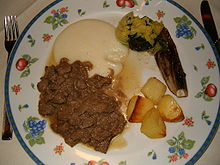 Venetan liver, or fegato alla veneziana in Italian, served with potatoes and sweetcorn.
Venetan liver, or fegato alla veneziana in Italian, served with potatoes and sweetcorn.
- Rixi e bixi: a poor but tasty dish consisting of a simple risotto with pancetta and peas cooked in a broth.
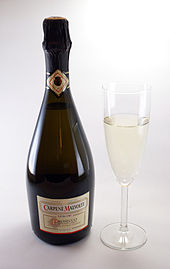 A bottle and glass of Prosecco, which can be spumante (the more expensive extra frizzy) or frizzante (the cheaper frizzy).
A bottle and glass of Prosecco, which can be spumante (the more expensive extra frizzy) or frizzante (the cheaper frizzy).
- Sardełe in saor: fired sardines, dipped in partially fried onion in the same oil in which they are fried sardines, raisins and pine nuts (traditionally only by winter to increase the calories), other spices and sprinkled with plenty of vinegar. One leaves everything to marinate at least one night.
- Mołeche: small green species crabs (Carcinus maenas), when they arrived at the peak of phase changes and then soft, they are fried. The mołeche are very valuable because the process of changing the water brackish lagoons lasts a few hours, the armor back hard and immediately return to be called maxenete.
- Rixoto de gò: rice prepared with goby (of the Gobius ophiocephalus species), also known as gò, typical fish of the Venetian Lagoon.
- Pasta e faxioi: bean soup with noodles (typically long pasta rough).
- Połenta e schie: small shrimp from the lagoon (gray mud, gray-brown from boiled), fried and perched on a bed of white polenta very soft.
- Sepe al nero: cuttlefish cooked with their ink lagoon.
- Fegato ała venesiana: a high-class Venetian plate of liver, chopped and cooked together with chopped onions.
- Bigołi in salsa: bigoli pasta served with an anchovy and onion sauce.
Among the many Venetian desserts, the most well-known are: the fritołe (or frittelle), the baicołi (or baicoli), xałeti (or zaletti), the pinsa (or pinza), the gałani (or galani), and the fugasa (or focaccia).
Vicenza
Vicenza, along with Venice, has one of the most distinctive cuisines in the Veneto. Previously, the Vicentians were often referred to as the magnagati or mangiagatti (meaning "cat eaters") due to the alleged presence of cats in their cuisine, though the cooking of cats is now illegal in Italy. Typical plates of the city and the surrounding area include:
- Asiago cheese
- Rubbio celery
- Serexe de Marostega (Marostica cherries)
- Nanto truffles
- Bassano del Grappa asparaguses
- I bixi de Lumignan and i bixi de Borso
- Semi-liquid polenta (sometimes served with tomato sauce or puree)
- Torexani de Breganse
- Rotzo potatoes
- Bacałà ała Visentina
- Rixi e bixi (rice and peas)
The rest of the Veneto
 Tiramisu, a well-known dessert from the Veneto region.
Tiramisu, a well-known dessert from the Veneto region.
- Tiramisu: one of the most popular desserts in Italy and Europe, it is made with chocolate, mascarpone, and dark-coffee-dipped savoiardi (a kind of Italian biscuits).
- Mandorlato: typical Venetian hard torrone, made in the town of Cologna Veneta.
- Pasta e faxioi ała veneta: a soup made by pasta, beans and bacon.
- Grigliata mista: mixed grilled meats, as pork ribs, pork sausages, pork chops, chicken breasts, bacon strips, beef ribs, always served together with grilled polenta.
- Gran bollito veneto (or bollito misto alla veneta): mixed boiled meats, beef, hen, beef tongue, cotechino, cooked together.
- Galletto alla brace: grilled cockerel.
- Maiale al latte: braised pork meat, cooked in the milk.
- Tripe ała veneta: tripe cooked with vegetables, butter and olive oil, then to be served dressed with grated grana cheese.
- Radicchio alla griglia: a Trevisan-based plate of grilled endive leaves.
- Porchetta trevigiana: often stuffed inside a panino.
- Gallina alla canèvera: a dish from a very old Padua or Vicenza tradition, dating back to the Middle-Age, in which hen meat is boiled together with mixed vegetables inside a pork bladder.
- Połenta bianca: a variety of polenta made by biancoperla cornmeal, it is typical of the plain areas but above all of the territories of Padua and Venice, and it has a white and not yellow colour.
- Sfilacci di cavallo: frayed dried horse meat, typical of Padua and its province, it can be traditionally used to dress a bigoli dish or eaten alone, but in modern years it is popular also to dress a pizza.
- Oca in onto: a goose marinated for some day in salt or herbes and under its own fat, to be cooked later, typical of the area of Padua.
- Bigołi al'arna: bigoli pasta served together with a duck meat sauce.
- Spezzatino di musso: donkey stew.
- Połenta e oxełi: roasted small birds, as quails, served together with polenta - this dish, at the time of the Republic of Venice, was exported to East Lombardy too, and in Bergamo a cake took the same name (polenta e osei).
- Casunziei.
- Pastìn: a typical food from Belluno, consists of mixed pork and beef meat, cut anyhow. Spices may be added in it, and this food is often eaten along with polenta.
- Brasato all'amarone: braised beef meat cooked with Amarone wine, often served together with polenta.
- Pastisada de caval: a dish from Veronese cuisine, dating back to the Middle-Age, in which horse meat is prepared with laurel, nutmeg, cloves, salt, pepper, vegetables, flour and beef broth, then served together with polenta.
- Lesso con la pearà: typical dish of Verona area, it consists of mixed meats boiled together with vegetables, beef and veal marrow, and broth.
- Tortellini di Valeggio: hand-made fresh pasta of tortellini kind, stuffed with a mix of beef and pork meats, and vegetables, usually served with melted butter and sage, they are typical of the town of Valeggio sul Mincio on the river Mincio, southwest of Verona.
- Riso Vialone Nano: a variety of rice typical of southern Veronese plain (Bassa Veronese), it is the rice used to prepare risotti across Veneto.
- Soppressa: typical Venetian soft salami, it can be garlic-added.
- Carpaccio.
Drinks and alcoholic beverages
Main article: Veneto wine- Prosecco: a popular sparkling wine, which is often secco, which is dry, or amabile, which gives it a relatively sweet taste.
- Pinot Grigio: one of the most common and prestigious wines of the region.
- Bianco di Custoza: also one of the best wines of the region, it is cultivated in the Soave region near lake Garda.
See also
References
Categories:- Venetian cuisine
- Veneto
- Italian regional cuisines
Wikimedia Foundation. 2010.

